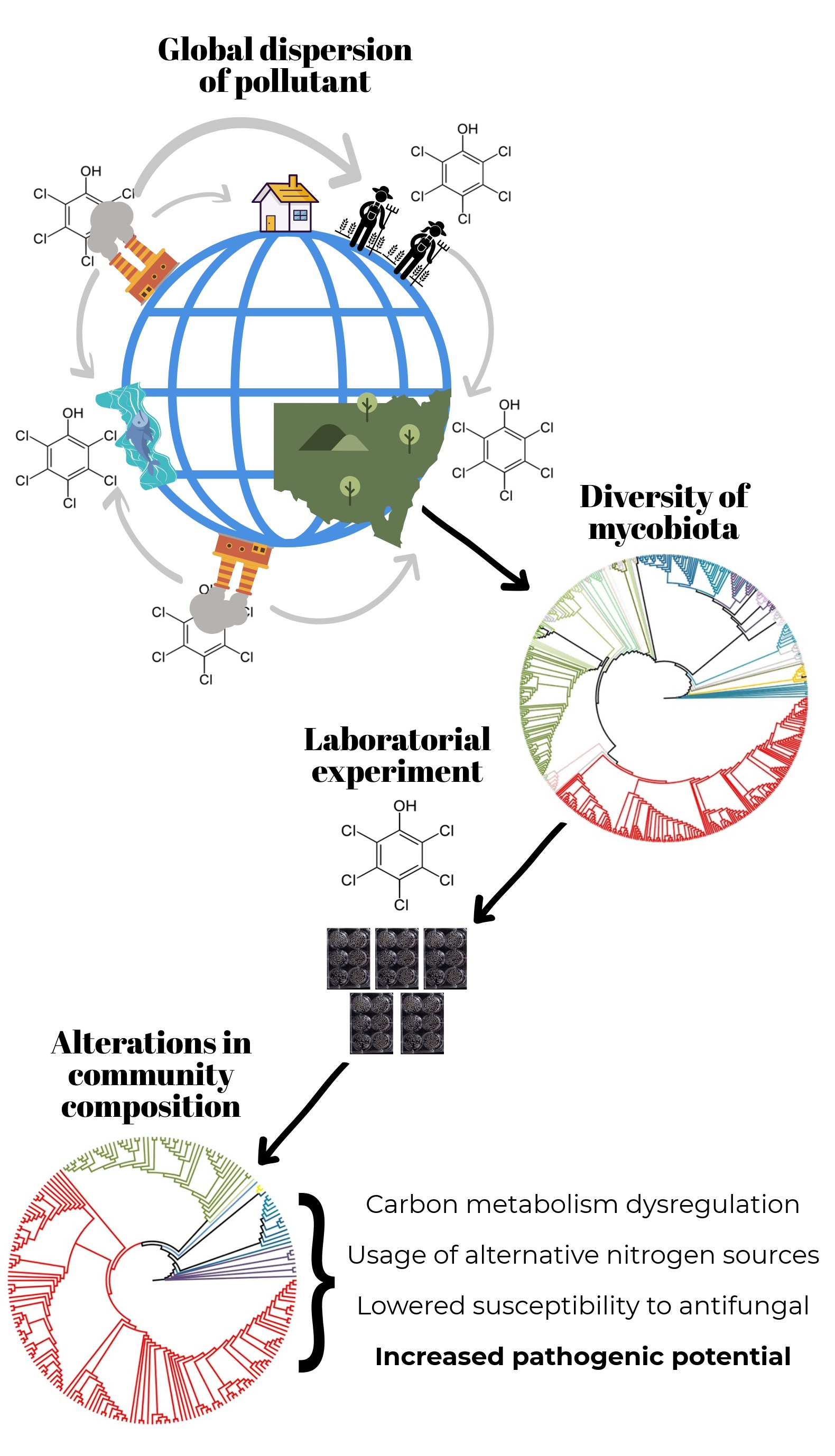
It is impossible to not be overwhelmed by the complexity, beauty, diversity, and extraordinary adaptations of fungi that help to safeguard Earth’s ecosystems. Despite this, fungi can also present a serious threat to all forms of life. Life-threatening fungal infections affect millions of vulnerable, immunocompromised individuals of all ages, worldwide. In recent decades, new emerging fungal pathogens are being discovered on a regular basis. The rise of fungal pathogenic potential has been linked to the growth of the most vulnerable population; to the intercontinental transfer of strains, due to the global mobility of people and goods; and to climate change and chemical pollution that seriously threatens the sustainability of Earth’s ecosystems.
The initial motivation for this study was to establish evidence that pollutants spread on a global scale are greatly affecting the functioning and diversity of belowground mycobiota. Studies of fungal diversity are still very much in their infancy: from the estimated 3 to 5 million species likely to exist on Earth we have only described 100,000 to date. The pace of discovery of new species is not sufficient to ensure accurate mapping how pollution is affecting fungal diversity.

How have we come to be involved in investigating this topic? We began by proving that the atmospheric persistent pollutant pentachlorophenol (PCP) is able to reach the soil of forest environments [1,2]. These early studies, which were funded by the NATO Science for Peace and Security programme, considered the soils of cork oak forests located in the NW of Tunisia. The analysis of these soils was unexpectedly challenging, yet persistence and teamwork resulted in the discovery that these soils contained both PCP and compounds derived from the PCP degradation pathway. This degradation pathway is used by the belowground fungal community - the first line of defence of the soil ecosystem. Finally, we were in a position where we were able to scrutinise the physiological cost of the trade-off between PCP degradation and survival. To increase the temporal and geographic significance of the study we decided to replicate, under laboratory conditions, a timeline of exposure to PCP pollution. We then studied the response of the fungal community along this timeline. Our results showed that cost, to fungi, of PCP exposure is high, regardless of their superior ability to degrade the biocide. The presence of PCP altered both the diversity and abundance of fungal species and, equally importantly, the presence of PCP greatly reduced the susceptibility of the community to a fungicide and triggered the secretion of proteins potentially associated with pathogenesis. We were initially sceptical yet all of the indicators we have scrutinised – genes, proteins and activities - supported the same theory. The hypothesis that exposure to PCP (or to other pollutants) may led to increased fungal pathogenicity cannot be ignored, especially as one potential outcome would be the dispersal of new airborne opportunistic pathogens that are capable of affecting both animal and plant hosts. We are now trying to understand the risk to human health posed by these pollution induced specialisation events in fungal communities. In addition we will begin the vital work of developing specific strategies to prevent the rise of fungal pathogenicity and to combat its spread!
Personal note: I am grateful to the contribution of all co-workers that have made this trip (and work) possible! My greatest appreciation goes to Celso Martins, my talented PhD student, and to my good friend and collaborator Andrew Hursthouse (UWS, UK) who was a key partner in the early stages of this line of research.
The paper in Microbiome is here: https://rdcu.be/bbTJP
*equal first authors
Follow the Topic
-
Microbiome

This journal hopes to integrate researchers with common scientific objectives across a broad cross-section of sub-disciplines within microbial ecology. It covers studies of microbiomes colonizing humans, animals, plants or the environment, both built and natural or manipulated, as in agriculture.
Related Collections
With Collections, you can get published faster and increase your visibility.
Harnessing plant microbiomes to improve performance and mechanistic understanding
This is a Cross-Journal Collection with Microbiome, Environmental Microbiome, npj Science of Plants, and npj Biofilms and Microbiomes. Please click here to see the collection page for npj Science of Plants and npj Biofilms and Microbiomes.
Modern agriculture needs to sustainably increase crop productivity while preserving ecosystem health. As soil degradation, climate variability, and diminishing input efficiency continue to threaten agricultural outputs, there is a pressing need to enhance plant performance through ecologically-sound strategies. In this context, plant-associated microbiomes represent a powerful, yet underexploited, resource to improve plant vigor, nutrient acquisition, stress resilience, and overall productivity.
The plant microbiome—comprising bacteria, fungi, and other microorganisms inhabiting the rhizosphere, endosphere, and phyllosphere—plays a fundamental role in shaping plant physiology and development. Increasing evidence demonstrates that beneficial microbes mediate key processes such as nutrient solubilization and uptake, hormonal regulation, photosynthetic efficiency, and systemic resistance to (a)biotic stresses. However, to fully harness these capabilities, a mechanistic understanding of the molecular dialogues and functional traits underpinning plant-microbe interactions is essential.
Recent advances in multi-omics technologies, synthetic biology, and high-throughput functional screening have accelerated our ability to dissect these interactions at molecular, cellular, and system levels. Yet, significant challenges remain in translating these mechanistic insights into robust microbiome-based applications for agriculture. Core knowledge gaps include identifying microbial functions that are conserved across environments and hosts, understanding the signaling networks and metabolic exchanges between partners, and predicting microbiome assembly and stability under field conditions.
This Research Topic welcomes Original Research, Reviews, Perspectives, and Meta-analyses that delve into the functional and mechanistic basis of plant-microbiome interactions. We are particularly interested in contributions that integrate molecular microbiology, systems biology, plant physiology, and computational modeling to unravel the mechanisms by which microbial communities enhance plant performance and/or mechanisms employed by plant hosts to assemble beneficial microbiomes. Studies ranging from controlled experimental systems to applied field trials are encouraged, especially those aiming to bridge the gap between fundamental understanding and translational outcomes such as microbial consortia, engineered strains, or microbiome-informed management practices.
Ultimately, this collection aims to advance our ability to rationally design and apply microbiome-based strategies by deepening our mechanistic insight into how plants select beneficial microbiomes and in turn how microbes shape plant health and productivity.
This collection is open for submissions from all authors on the condition that the manuscript falls within both the scope of the collection and the journal it is submitted to.
All submissions in this collection undergo the relevant journal’s standard peer review process. Similarly, all manuscripts authored by a Guest Editor(s) will be handled by the Editor-in-Chief of the relevant journal. As an open access publication, participating journals levy an article processing fee (Microbiome, Environmental Microbiome). We recognize that many key stakeholders may not have access to such resources and are committed to supporting participation in this issue wherever resources are a barrier. For more information about what support may be available, please visit OA funding and support, or email OAfundingpolicy@springernature.com or the Editor-in-Chief of the journal where the article is being submitted.
Collection policies for Microbiome and Environmental Microbiome:
Please refer to this page. Please only submit to one journal, but note authors have the option to transfer to another participating journal following the editors’ recommendation.
Collection policies for npj Science of Plants and npj Biofilms and Microbiomes:
Please refer to npj's Collection policies page for full details.
Publishing Model: Open Access
Deadline: Jun 01, 2026
Microbiome and Reproductive Health
Microbiome is calling for submissions to our Collection on Microbiome and Reproductive Health.
Our understanding of the intricate relationship between the microbiome and reproductive health holds profound translational implications for fertility, pregnancy, and reproductive disorders. To truly advance this field, it is essential to move beyond descriptive and associative studies and focus on mechanistic research that uncovers the functional underpinnings of the host–microbiome interface. Such studies can reveal how microbial communities influence reproductive physiology, including hormonal regulation, immune responses, and overall reproductive health.
Recent advances have highlighted the role of specific bacterial populations in both male and female fertility, as well as their impact on pregnancy outcomes. For example, the vaginal microbiome has been linked to preterm birth, while emerging evidence suggests that gut microbiota may modulate reproductive hormone levels. These insights underscore the need for research that explores how and why these microbial influences occur.
Looking ahead, the potential for breakthroughs is immense. Mechanistic studies have the power to drive the development of microbiome-based therapies that address infertility, improve pregnancy outcomes, and reduce the risk of reproductive diseases. Incorporating microbiome analysis into reproductive health assessments could transform clinical practice and, by deepening our understanding of host–microbiome mechanisms, lay the groundwork for personalized medicine in gynecology and obstetrics.
We invite researchers to contribute to this Special Collection on Microbiome and Reproductive Health. Submissions should emphasize functional and mechanistic insights into the host–microbiome relationship. Topics of interest include, but are not limited to:
- Microbiome and infertility
- Vaginal microbiome and pregnancy outcomes
- Gut microbiota and reproductive hormones
- Microbial influences on menstrual health
- Live biotherapeutics and reproductive health interventions
- Microbiome alterations as drivers of reproductive disorders
- Environmental factors shaping the microbiome
- Intergenerational microbiome transmission
This Collection supports and amplifies research related to SDG 3, Good Health and Well-Being.
All submissions in this collection undergo the journal’s standard peer review process. As an open access publication, this journal levies an article processing fee (details here). We recognize that many key stakeholders may not have access to such resources and are committed to supporting participation in this issue wherever resources are a barrier. For more information about what support may be available, please visit OA funding and support, or email OAfundingpolicy@springernature.com or the Editor-in-Chief.
Publishing Model: Open Access
Deadline: Jun 16, 2026

Please sign in or register for FREE
If you are a registered user on Research Communities by Springer Nature, please sign in
this is a compelling and powerful argument Cris, our capability to start to probe what is a very swiftly moving target can only come from dedicated, concerted and innovative approaches. Really pleased to have been part of the journey (so far!) and supporting you and the team along the way. There is plenty more to do. I am up for that!
It also begs questions around different stressors, levels and duration. I see a lot from historical legacy (we look at AMR v environmental degradation over decades) and the need for understanding shocks from rapid and extreme exposures in the environments of some emerging economies.
The start (or rather acceleration) of a more elaborate conversation